APES: Unit 1 Test (EVERYTHING)
1/110
There's no tags or description
Looks like no tags are added yet.
Name | Mastery | Learn | Test | Matching | Spaced |
|---|
No study sessions yet.
111 Terms
1.1: Biosphere
the regions of the lithosphere (land), atmosphere (air), and hydrosphere (water) of the Earth occupied by living organisms (basically anywhere on Earth where life exists)
1.1 Biome
a large area that has a similar climate which determines what kinds of plants and animals can live there (ex. tropical rainforest, desert, etc)
1.1 Ecosystem
all of the living (biotic) and non-living (abiotic) things that interact in an area (ex. plants, animals (biotic); rocks, soil, water, air (abiotic)
Biotic
living things
Abiotic
non-living things
Ecosystems are not...
boundary clear! The boundaries of ecosystems can overlap.
1.1 Community
all of the living organisms in a given area (ex. elk, beavers, trees, grass, and fungi)
1.1 Population
a group of organisms that are all the same species (ex. a HERD of elk)
1.1 Individual
one single organism (ex. one elk)
1.1 Symbiosis
- any close and long-term interaction between two organisms of different species
- this can happen either via mutualism, commensalism, or parasitism
Mutualism
a relationship between two species in which both species benefit (ex. coral reefs! coral animals provide a reef structure and CO2 for algae; algae provide sugar for coral to use as energy (via photosynthesis) and lichen which is an organism of fungi living with algae that provides nutrients for the coral)
Commensalism
a relationship between two organisms in which one organism benefits and the other is unaffected (ex. birds nests! when birds build their nests on tree trunks, they benefit because the tree gives them a place to live; but, the tree isn't harmed or benefitted from the nest being there, so the tree is unaffected)
Parasitism
a relationship between two organisms in which one organism (the parasite) benefits at the expense of another organism (the host); AKA: one organism benefits and the other is harmed (ex. malaria parasites! malaria parasites latch onto a host (like a dog) so that they can live, but in turn, they hurt the dog by giving it malaria and making it sick)
1.1 Predation
- when one organism uses another for its food/energy source (ex. hunters and parasites)
- there are 4 main types of predators: parasitoids, herbivores, true predators, and parasites
Parasitoids
organisms that lay eggs inside a host organism; eggs hatch, and larvae then eat the rest of the host for energy (ex. a botfly)
Herbivores
predators that eat plants for energy (ex. a giraffe)
True Predators
predators that kill their prey and consume most of what they kill for energy (ex. a leopard)
Parasites
an organism that lives/uses a host organism for energy (ex. a mosquito)
1.1 Predator-Prey Graph Relationships
- when the amount of prey is at its maximum, the amount of predators increases (more food, more babies)
- when predators are at their minimum, the amount of prey increases
- when there is an increase in predators, the amount of prey declines
- when the amount of prey declines, the amount of predators declines (b/c of the lack of food)
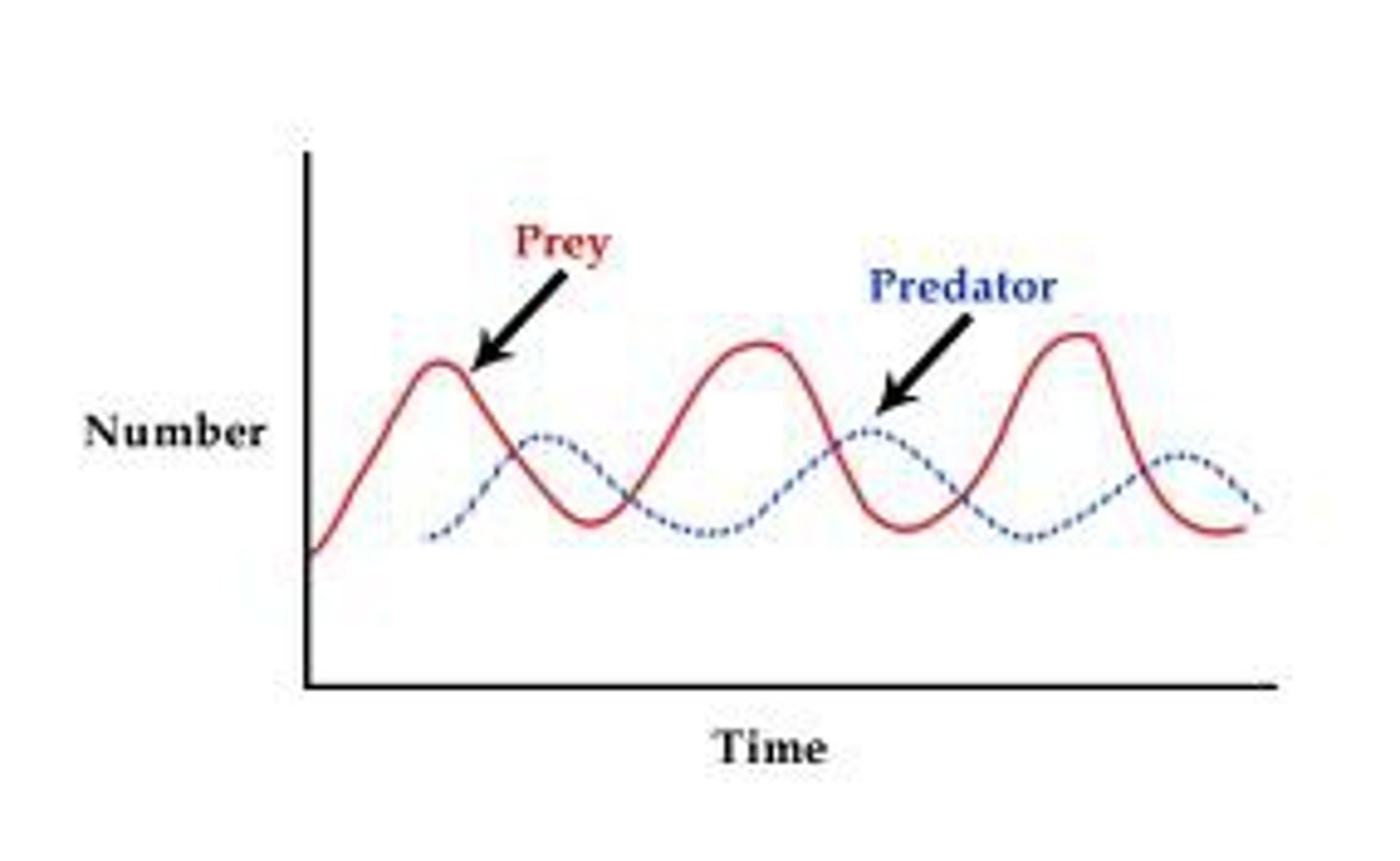
What disrupts the predator-prey relationship?
natural disasters and disease
1.1 Competition
when organisms fight over a resource like food, water, or shelter; limits the population size because less resources are available (limited resources)
1.1 Partitioning
there are 4 strategic ways that organisms partition their resources so that they can co-exist: 1) resource partitioning, 2) temporal (time) partitioning, 3) spatial partitioning, and 4) morphological partitioning
Resource Partitioning
allows different species to use the same resource in different ways to reduce competition (has to do with evolution favoring traits that allows different organisms to use the same species in different ways)
Temporal (time) Partitioning
species that compete for a shared resource that use that resource at different times (ex. wolves and coyotes hunt at different times of the day to avoid direct competition)
Spatial Partitioning
using different areas of a shared resource/habitat (ex. blades of grass with different lengths of roots allow the soil to be shared instead of the grass having to directly compete for water and nutrients since the roots are at different levels)
Morphological Partitioning
using different resources based on different evolved body features
1.1 Types of Interaction: Competition
Species 1 (-)
Species 2 (-)
1.1 Types of Interaction: Predation
Species 1 (+)
Species 2 (-)
1.1 Types of Interaction: Mutualism
Species 1 (+)
Species 2 (+)
1.1 Types of Interaction: Commensalism
Species 1 (+)
Species 2 (nothing: 0)
1.2 Tropical Rainforest
Climate: warm temps throughout the year
Precipitation: high precipitation
Soil: mineral poor because of too much rain; little organic material accumulates; quick decomposition because of warm temp
Vegetation: evergreen flowering plants with three distinct layers of vegetation (ground, canopy, etc.)
Animals: 90% live in the canopy - insects, reptiles, amphibians, highly colored birds, mammals: sloth, monkeys, and elephants
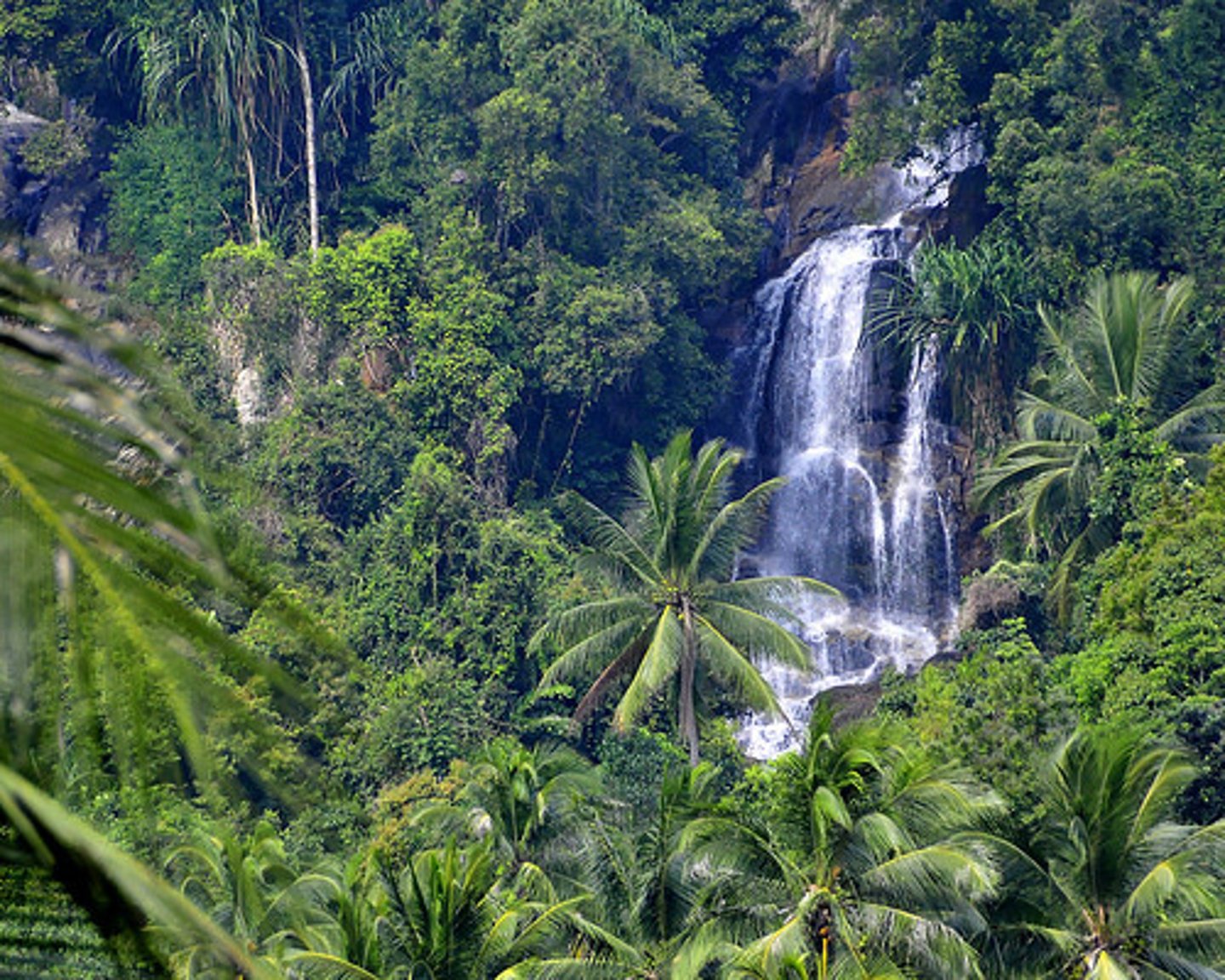
1.2 Taiga (Boreal)
Climate: long cold, severe winters and short warm summers
Precipitation: okay amount of precipitation in the summer
Soil: is acidic and mineral-poor
Vegetation: spruce, fir, conifers, a few deciduous trees
Animals: large mammals: caribou, wolves, bear, moose; small mammals: lynx, hare, abundant insects; few amphibians and reptiles
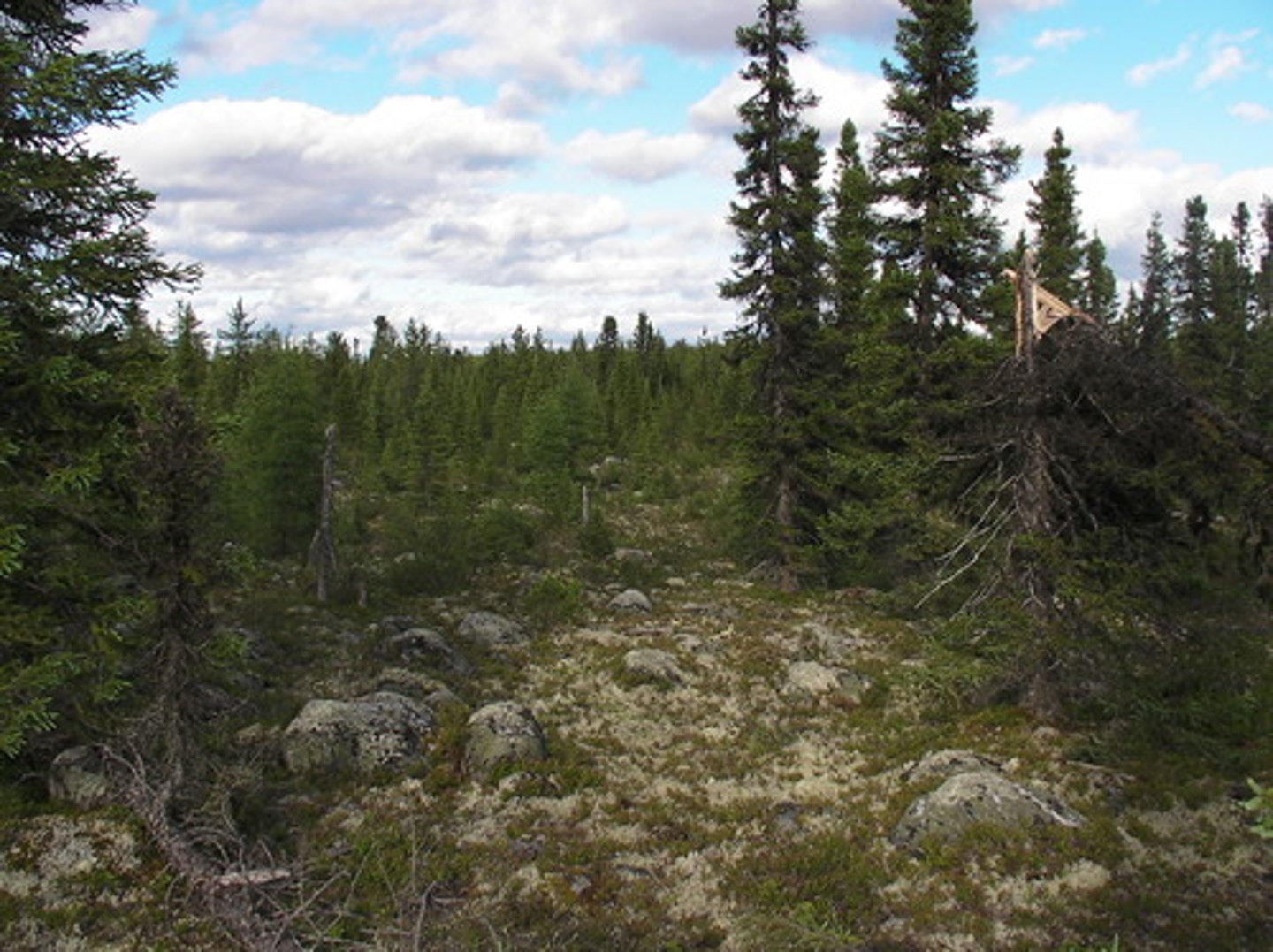
1.2 Temperate Deciduous Forest
Climate: hot summers, cold winters
Precipitation: good amount of rain (not too much not too little)
Soil: topsoil is rich in organic material; mineral ions are released as organic material is decomposed
Vegetation: broadleaved trees (oak, hickory, beech); trees form dense canopy over saplings and shrubs
Animals: originally large mammals: puma, wolves, bison; actually: deer, bears, many small mammals and birds
1.2 Grasslands
Climate: hot summers, cold winters
Precipitation: kind of uncertain; okay amount of rain
Soil: high in organic material
Vegetation: few trees; large amounts of grass; ideal for growing corn and wheat
Animals: bison, elk, wolves, prairie dogs, coyotes, many reptiles, and many insects (all of the animals and the land is adapted to wildfires)
1.2 Desert
Climate: daily temps are either extremely hot or extremely cold (cold desert)
Precipitation: VERY little rain
Soil: low in organic material, high in mineral content
Vegetation: sparse, so soil is exposed; cacti, yucca, sagebrushes
Animals: small animals: insects, amphibians, reptiles, rattlesnakes, gerbils, fox, and jackrabbits
1.2 Tundra
Climate: long, harsh winters; long days in the summer
Precipitation: very little rain
Soil: nutrient poor, little organic litter; permafrost (frozen soil on the surface that has anaerobic bacteria)
Vegetation: mosses, lichen, and other grasslike plants
Animals: small mammals: birds; caribou in the summer; no amphibians or reptiles
The community or organisms in a biome are...
adapted to live in that biome.
1.2 Latitudes
Tundra and Boreal Forest: high latitude (far from equator)
Temperate Forests: mid latitude (just above equator)
Tropical Forests: lower latitude (very close to equator)
1.2 Shifting Biomes
biomes shift in location on Earth as climate changes (ex. warming climate will shift boreal forests further North as tundra permafrost melts and lower latitudes become too warm for aspen and spruce)
1.2 Nutrient Availability
the amount and type of nutrients available determines which plants can survive in a biome
1.2 Nutrient Availability Examples
1. tundra: b/c the soil in the tundra is frozen year-round, nutrients in dead organic matter can't be broken down and nutrients can't be recycled--SO: few plants survive because of low soil and water nutrients/availability
2. tropical rainforest: nutrient-poor soil in the tropical rainforest because of high precipitation
3. boreal forest: nutrient-poor soil (low temp. and low decomposition rate of dead organic matter)
4. temperate forest: nutrient-RICH soil because there is lots of dead organic matter and warm temps that leave moisture for decomposition
1.3 Aquatic Biomes Definition
salinity, flow, depth, and temperature
Salinity
how much salt there is in a body of water which determines which species can survive and usability for drinking
Flow
the movement of H2O; determines which plants and organisms can survive and how much oxygen can dissolve into water (faster flow = better oxygen dissolving)
Depth
influences how much sunlight can penetrate and reach plants below the surface for photosynthesis
Temperature
warmer water holds LESS dissolved oxygen so it supports FEWER aquatic organisms (organisms require dissolved oxygen for survival)
1.3. Rivers
high oxygen due to the flow/movement of water facilitates the mixing of air and water (also carries nutrient-rich sediments (deltas and flood plains make fertile soil)
1.3 Lakes
standing bodies of fresh H2O (key drinking source)
What are the four zones in a lake?
littoral, limnetic, profundal, and benthic
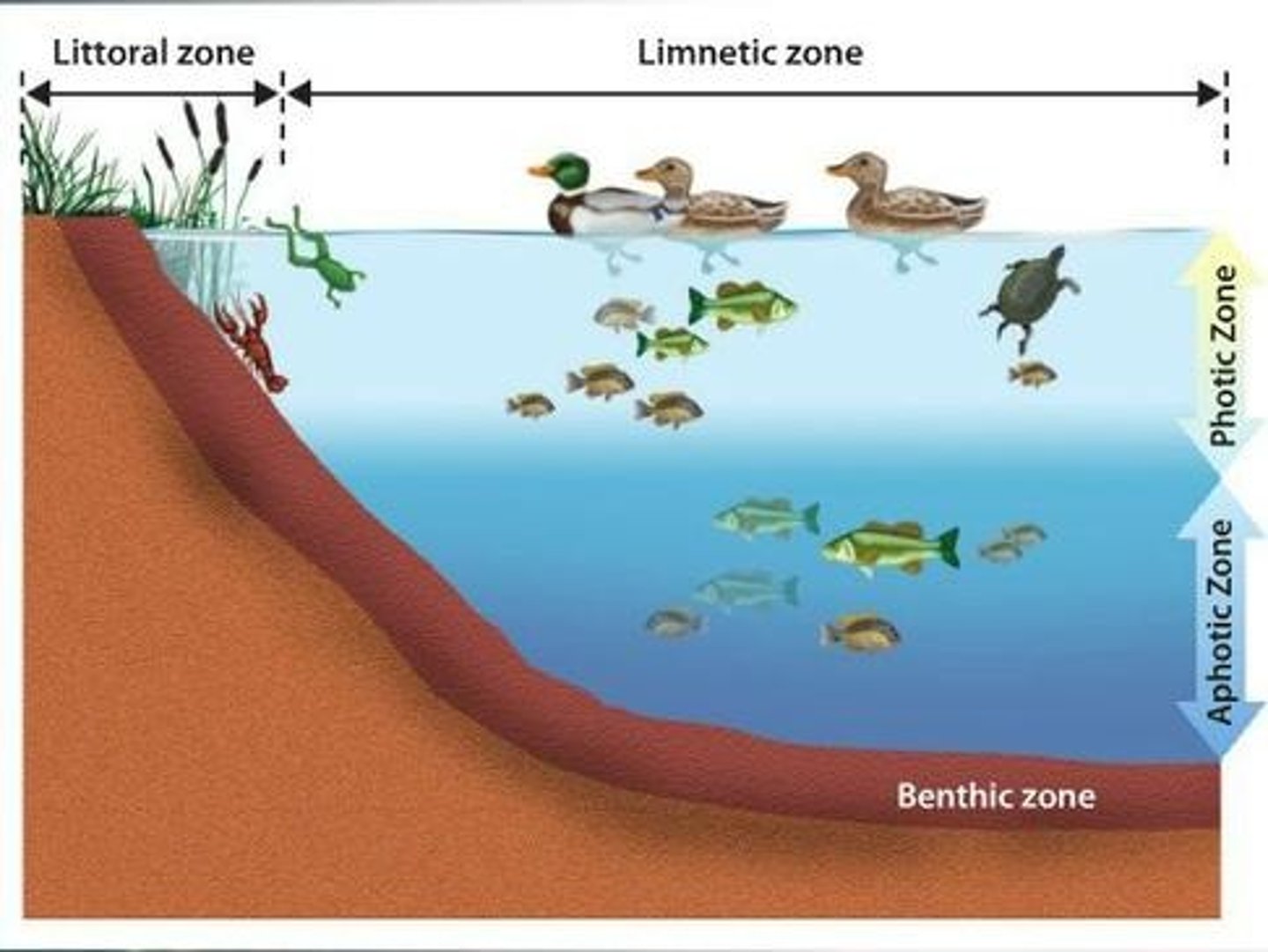
Littoral
a shallow zone in a freshwater habitat where light reaches and nurtures emergent plants
Limnetic
a zone in a freshwater habitat where light can reach for photosynthesis of phytoplankton (no rooted plants, only phytoplankton)
Profundal
a deep zone in a freshwater habitat that is too deep for sunlight (no photosynthesis)
Benthic
murky bottom zone of a freshwater habitat -- consists of sand and sediment and supports its own community of organisms; has nutrient-rich soil
1.3 Freshwater Wetlands
- area with soil submerged/saturated in water for at least part of the year, but shallow enough for emergent plants
- plants living in wetlands have to be adapted to living with their roots submerged in standing water like lily pads, cattails, and reeds (most plants can't live with their roots submerged in water since they don't get enough oxygen this way, therefore, ONLY adapted plants can survive in wetlands)
1.3 Benefits of Wetlands
1) stores excess water during storms; lessens floods
2) recharges groundwater by absorbing rainfall into soil
3) roots from wetland plants filter pollutants from water draining through
4) high plant growth due to lots of water and nutrients (dead organic matter) in sediments
1.3 Estuaries
- areas where rivers empty into oceans; nutrient-rich on the bottom
- are a mix of freshwater and salt water (species adapt to this like mangrove trees)
- high productivity (plant growth) in estuaries because of the nutrients in sediments that are deposited in estuaries by rivers
1.3 Examples of Estuaries
1) Salt Marsh: estuary habitat along the coast of temperate climates; good breeding ground for many fish and shellfish species
2) Mangrove Swamps: estuary habitat along the coast of tropical climates; mangrove trees have long, stilt, perched-up roots that stabilize the shoreline and provide habitats for species of fish and shellfish (they also have manatees)
1.3 Saltwater Biomes: Intertidal Zones
- where waves crash)
- a narrow band of coastline between high and low tide; organisms must be adapted to survive crashing waves and direct heat from sunlight during low tide; also, organisms to adapt to living in different areas of the intertidal zones
- ex. barnacles, sea stars, and crabs that attach themselves to rocks and have shells/tough outer skin
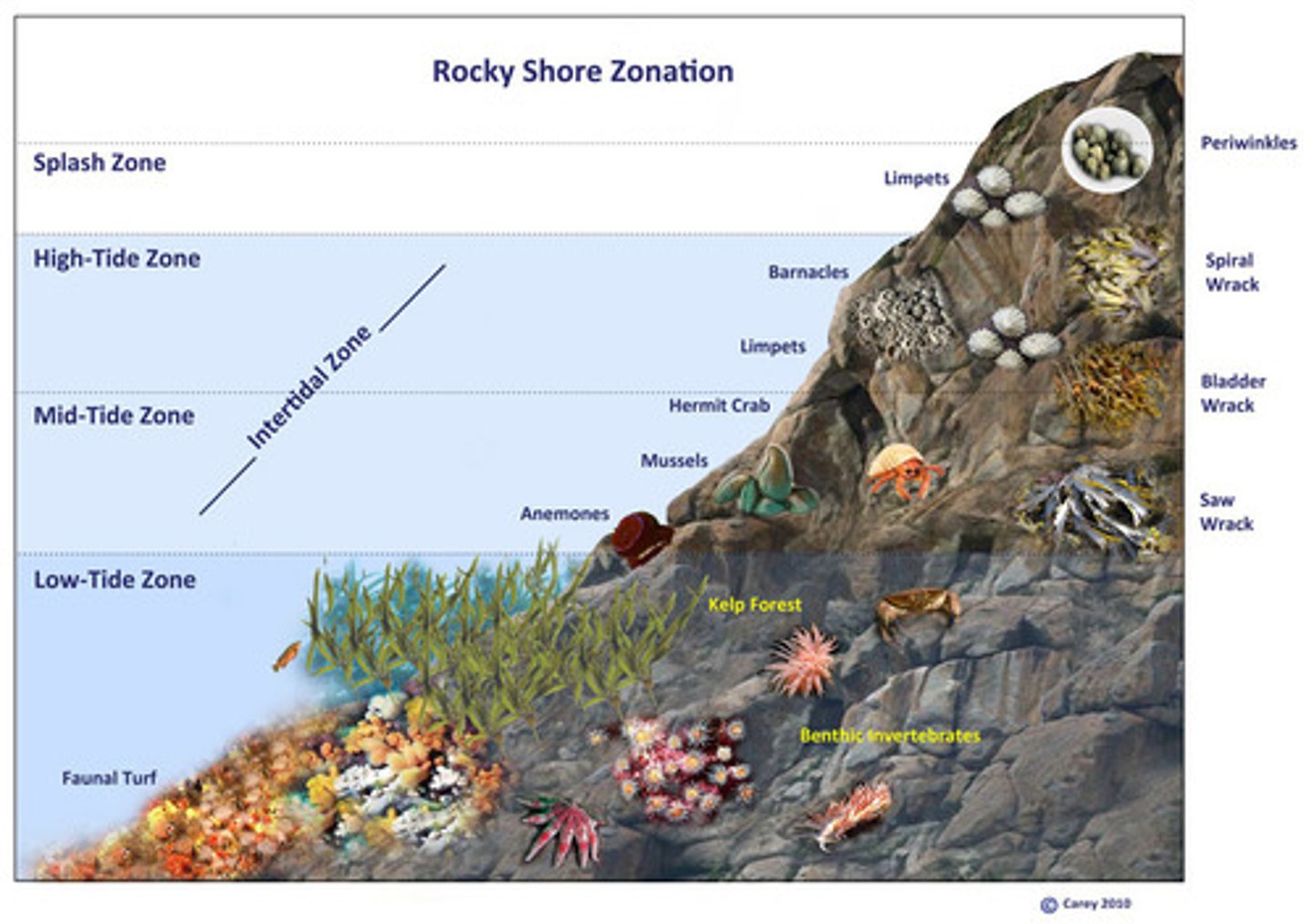
1.3 Saltwater Biomes: Coral Reefs
- found in warm, shallow waters beneath the shoreline (most diverse biome on Earth... basically the rainforests of the water)
- mutual relationship between the coral (animal) and the algae (plant)
- coral takes CO2 out of the ocean to make a calcium carbonate exoskeleton (the reef) and give CO2 to algae
- algae live in reef and provide energy via sugar to the coral through photosynthesis
1.3 Saltwater Biomes: Open Ocean
- low productivity biome per unit of area since only algae and phytoplankton plants can live in the majority of the ocean
- but, the ocean is so large that phytoplankton and algae produce a lot of the Earth's oxygen and absorb a ton of atmospheric CO2
- has a photic and aphotic zone
Photic Zone
area in the ocean where sunlight can reach for photosynthesis
Aphotic/Abyssal Zone
zone too deep for sunlight; no photosynthesis
1.4 Steps of the Carbon Cycle
1. Photosynthesis
Plants and algae take in CO₂ from the atmosphere and H₂O from the soil, using sunlight to convert them into glucose (C₆H₁₂O₆) and oxygen (O₂).
This process stores carbon in plant tissues and releases O₂ into the atmosphere.
2. Respiration
Plants and animals use C₆H₁₂O₆ and O₂ for energy, breaking them down to produce CO₂ and H₂O as waste products, which are released back into the atmosphere.
This balances photosynthesis, cycling CO₂ back into the air.
3. Consumption
Carbon moves up the food chain as animals eat plants and other animals, storing carbon in their bodies temporarily.
4. Decomposition
When organisms die, decomposers break down their bodies, releasing CO₂ into the atmosphere and adding organic carbon to the soil.
5. Sedimentation
Carbon from decomposed organisms on land and from marine organisms in the ocean settles into sediments, forming layers of carbon over millions of years.
This process eventually creates rock formations, trapping carbon in the Earth’s crust for long-term storage.
6. Fossil Fuel Formation and Combustion
Organic material buried for millions of years transforms into fossil fuels. When these fuels are burned, stored carbon is released as CO₂, adding to atmospheric levels.
7. Ocean Absorption and Sedimentation
Oceans absorb atmospheric CO₂. Some CO₂ dissolves, forming carbonic acid, while some become part of marine sediments (e.g., carbonate rocks like limestone), locking carbon into ocean floors.
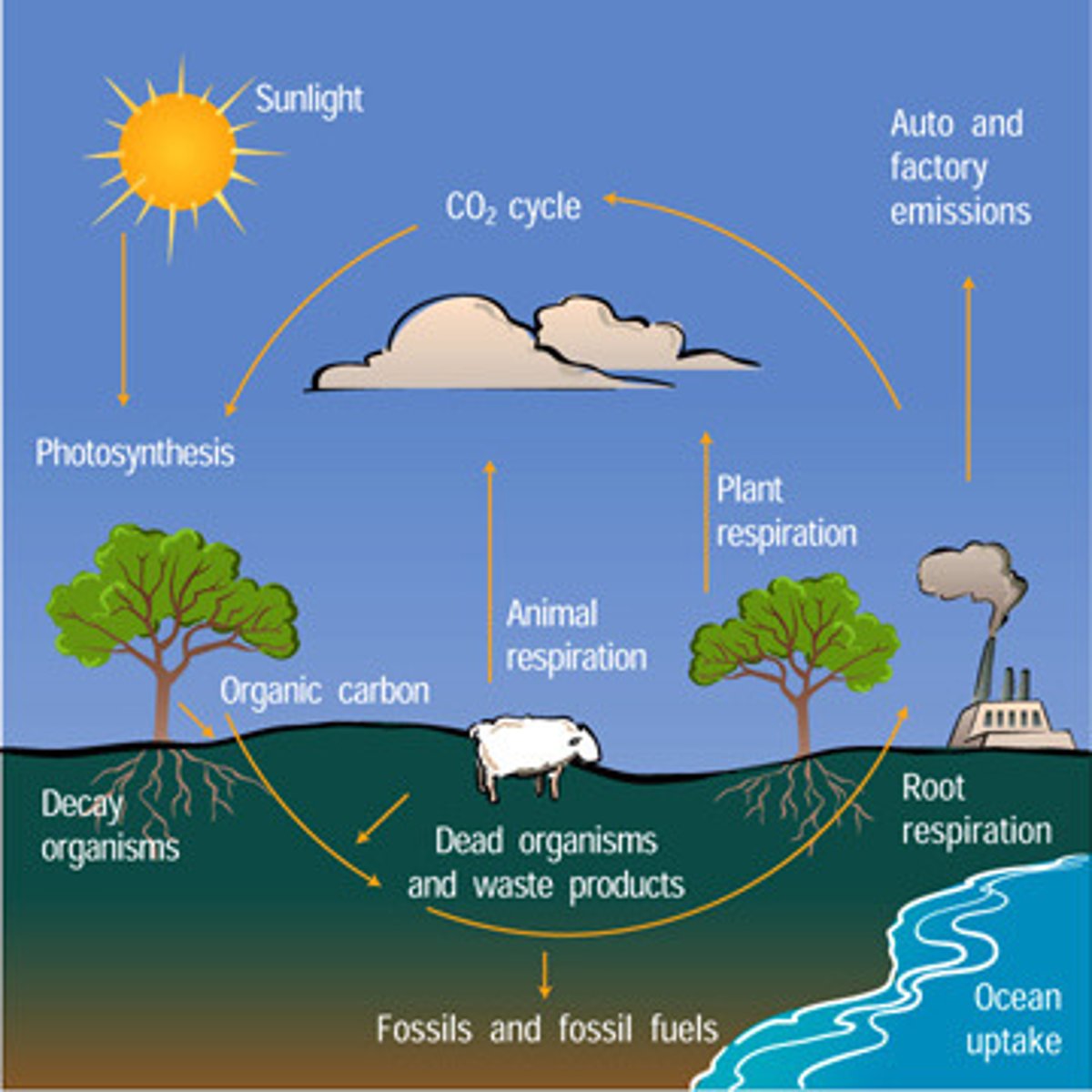
1.4 Main Reservoir of Carbon
the ocean
1.4 Carbon in the Ocean and Atmosphere
- CO2 has a direct exchange between the atmosphere and the ocean by dissolving into and out of surface ocean H2O (this happens quickly and is balanced; but, increasing atmospheric CO2 leads to ocean acidification which can kill ocean species)
- algae and phytoplankton take CO2 out of the ocean and the atmosphere via photosynthesis (and coral reefs for calcium carbonate exoskeleton)
1.4 Carbon in Burial, Extraction, and Combustion
1) Burial: slow, geological process that stores carbon in underground sinks like sedimentary rocks or fossil fuels; sediments of rocks, soil, and organic matter that are compressed into sedimentary rock or fossil fuels by pressure form overlying rock layers or water
2) Extraction and Combustion: digging up or mining fossil fuels and burning them as an energy source (releases CO2)
As the carbon in the atmosphere increases...
global temperatures increase.
1.4 Photosynthesis
- plants, algae, and phytoplankton use CO2 from the atmosphere and H2O from the soil to and convert it to glucose and O2
- photosynthesis is a CO2 sink
CO2 Sink
a carbon reservoir that stores more carbon than it releases
1.4 Cellular Respiration
- plants and animals use O2 to break glucose down and release energy and CO2 and H2O which fuels their movement, growth, and metabolism
- CO2 source
CO2 Source
a carbon reservoir that releases more carbon than it stores
Both photosynthesis and cellular respiration happen...
quickly.
1.4 Fossil Fuels
coal, oil, and natural gas that are formed from fossilized remains of organic matter (ex. dead ferns (coal) or marine algae and plankton (oil))
1.5 Steps of the Nitrogen Cycle
1. Nitrogen Fixation
Nitrogen gas (N₂) from the atmosphere is converted into ammonia (NH₃) by nitrogen-fixing bacteria in soil or plant roots, or by lightning.
This process makes nitrogen available in a form plants can eventually use.
2. Nitrification
Soil bacteria convert ammonia (NH₃) into nitrite (NO₂⁻) and then into nitrate (NO₃⁻), which plants can absorb as nutrients.
3. Assimilation
Plants take up nitrates (NO₃⁻) and incorporate nitrogen into proteins and other molecules.
Animals then consume plants, transferring nitrogen through the food chain.
4. Ammonification (Decomposition)
Decomposers break down organic matter from dead plants and animals, converting nitrogen back into ammonia (NH₃) or ammonium (NH₄⁺) in the soil.
5. Denitrification
In low-oxygen environments, denitrifying bacteria convert nitrate (NO₃⁻) back into nitrogen gas (N₂), releasing it into the atmosphere.
This step completes the cycle, returning nitrogen to the air.
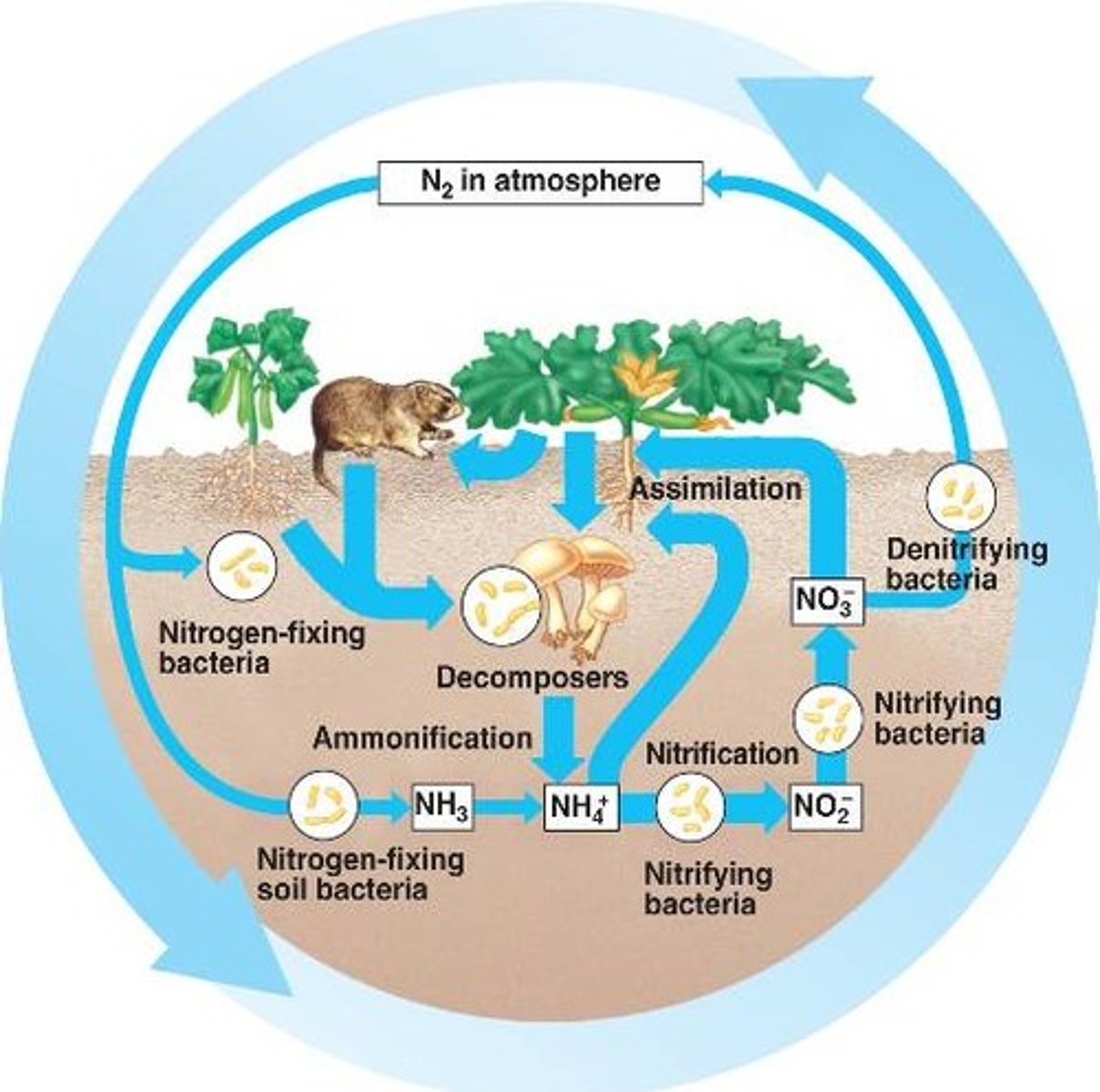
1.5 Main Reservoir of Nitrogen
the atmosphere
How long do nitrogen reservoirs hold nitrogen for?
a very short amount of time compared to the carbon cycle which can hold carbon for millions of years
All living things need ________ to survive because it is needed for DNA and amino acids to make proteins.
nitrogen
1.5 Nitrogen Fixation
- process of N2 gas being converted into biologically available NH3 (ammonia) or NO3 (nitrate) (after being nitrite first)
- 2 types of fixation: bacterial and synthetic
Bacterial Fixation
certain bacteria that live in the soil, or in symbiotic relationship with plant root nodules convert N2 into ammonia (NH3)
Synthetic Fixation
humans combust fossil fuels to convert N2 gas into nitrate (NO3); nitrates are added to synthetic fertilizers like Miracle Grow and are used in agriculture
1.5 Assimilation
plants and animals take in N2 gas and incorporate it into their bodies; plant roots take in NO3 or NH3 from soil; animals assimilate nitrogen by eating the plants (or eating other animals who eat plants if they are carnivores)
1.5 Ammonification
soil bacteria, microbes, and decomposers convert waste and dead biomass into NH3 (ammonia) and returning it to the soil
1.5 Nitrification
conversion of NH4 (ammoniUM) into NO2 (nitrite) and then into NO3 (nitrate); it can't just stop after converting NH4 to NO3 because NO3 isn't usable for plants and animals
1.5 Denitrification
conversion of soil nitrogen (which is in the form of NO3) into N2O (nitrous oxide) GAS which returns into the atmosphere
1.5 Human Impacts on the Nitrogen Cycle
1) Climate: N2O (nitrous oxide gas) is a greenhouse gas that warms earth's climate (produced by denitrification of nitrate in agricultural soils (especially when they are overwatered)
2) Ammonia Volatilization: excess fertilizer can lead to NH3 gas entering the atmosphere which causes acid precipitation
3) Leaching and Eutrophication: synthetic fertilizer use leads to NO3 leaching (NO3 being carried out of the soil by water) --> this fuels aggressive algae growth that prevents sunlight from reaching aquatic life
1.6 Phosphorous Cycle Steps
1. Weathering
Phosphorus is mainly stored in rocks. Weathering breaks down rocks, releasing phosphate ions (PO₄³⁻) into soil and water, making them available to plants.
2. Absorption by Plants
Plants absorb phosphate from the soil and use it to form essential molecules like DNA and ATP.
Phosphorus then moves through the food chain as animals eat plants.
3. Movement Through the Food Chain
Phosphorus is incorporated into animal tissues, supporting cellular processes.
When animals consume plants (or other animals), they also take in phosphorus.
4. Decomposition
When plants and animals die, decomposers break down their tissues, returning phosphorus to the soil as phosphate.
Animal waste also contributes phosphorus to the soil.
5. Human Use: Detergents and Cleaners
Phosphates are often used in household detergents and cleaners because they enhance cleaning effectiveness.
When these products are used, phosphate residues enter water systems through wastewater.
6. Eutrophication in Water Bodies
Excess phosphates from detergents and agricultural runoff can accumulate in lakes and rivers, leading to algal blooms in a process called eutrophication.
Algal blooms deplete oxygen in the water, harming aquatic life.
7. Sedimentation
Phosphorus eventually settles as sediment in oceans or lakes, where it can become part of new rock layers over time, storing phosphorus long-term.
8. Geological Uplift
Geological uplift brings phosphate-rich rocks to the surface, where weathering restarts the cycle.
1.6 Major Reservoir of Phosphorous
phosphorous containing rocks and minerals
1.6 Natural Phosphorous Sources
major natural source is the weathering of rocks that contain phosphorous minerals; wind and rain break down the rock and phosphate gets released and dissolved into water; then, rain water carries phosphate into nearby soil and bodies of water (remember, weathering is a VERY SLOW PROCESS)
1.6 Synthetic Phosphorous Sources
- mining phosphate materials
- adding products to synthetic fertilizers and detergents/cleaners
1.6 Assimilation and Excretion/Decomposition
- just like nitrogen, phosphorous is absorbed by plant roots and assimilated into tissues; animals assimilate phosphorous by eating plants or other animals
- animal waste, plant matter, and other biomass is broken down by bacteria/soil decomposers that return phosphate to the soil
1.6 Sedimentation
- phosphate doesn't dissolve well in water, so much of it forms solid bits that fall to the bottom of the ocean as sediment
- phosphorous sediments then get compressed into sedimentary rocks like limestone over LONG periods of time
1.5 and 1.6 Eutrophication (too much Nitrogen or too much Phosphorous)
1) too much nitrogen and/or phosphorous
2) algae bloom is created that covers the surface of the water, blocks the sunlight, and ultimately kills the plants below the surface
3) algae eventually die"s off; the bacteria that breaks down algae use O2 in the water (since decomposition is AEROBIC)
4) lower O2 levels (dissolved oxygen) in the water kills aquatic animals (especially fish)
5) bacteria use up even more O2 to decompose dead animals
6) creates a positive feedback loop!! (less O2 --> more dead organisms --> more bacterial decomposition --> less O2)
1.7 Hydrologic Cycle Steps
1. Evaporation
Water from oceans, lakes, rivers, and soil is heated by the sun and turns into water vapor, rising into the atmosphere.
2. Transpiration
Plants absorb water from the soil, and as it moves through the plant to the leaves, it’s released as water vapor through small pores (stomata).
This process, called transpiration, contributes significantly to atmospheric moisture.
3. Condensation
Water vapor cools as it rises and condenses into tiny droplets, forming clouds.
This change from vapor to liquid or ice forms visible cloud masses in the atmosphere.
4. Precipitation
When water droplets in clouds grow heavy, they fall to Earth as precipitation (rain, snow, sleet, or hail).
Precipitation replenishes surface water in rivers, lakes, oceans, and soil.
5. Infiltration and Percolation
Some of the precipitation infiltrates the ground, moving through soil and rocks in a process called percolation.
This water recharges groundwater supplies, filling aquifers.
6. Runoff
Water that doesn’t infiltrate the soil flows across the surface as runoff, eventually reaching rivers, lakes, and oceans.
Runoff helps return water to larger bodies, completing part of the cycle.
7. Groundwater Flow
Groundwater slowly moves through subsurface layers and can feed into rivers, lakes, or oceans over time.
This process ensures a continuous supply of water to ecosystems and surface bodies.
1.7 Major Reservoir of Water
oceans (glaciers and groundwater too, but these are freshwater)
What drives the water cycle?
energy from the sun
1.7 Evaporation
liquid H2O becomes water VAPOR (gas) in the atmosphere
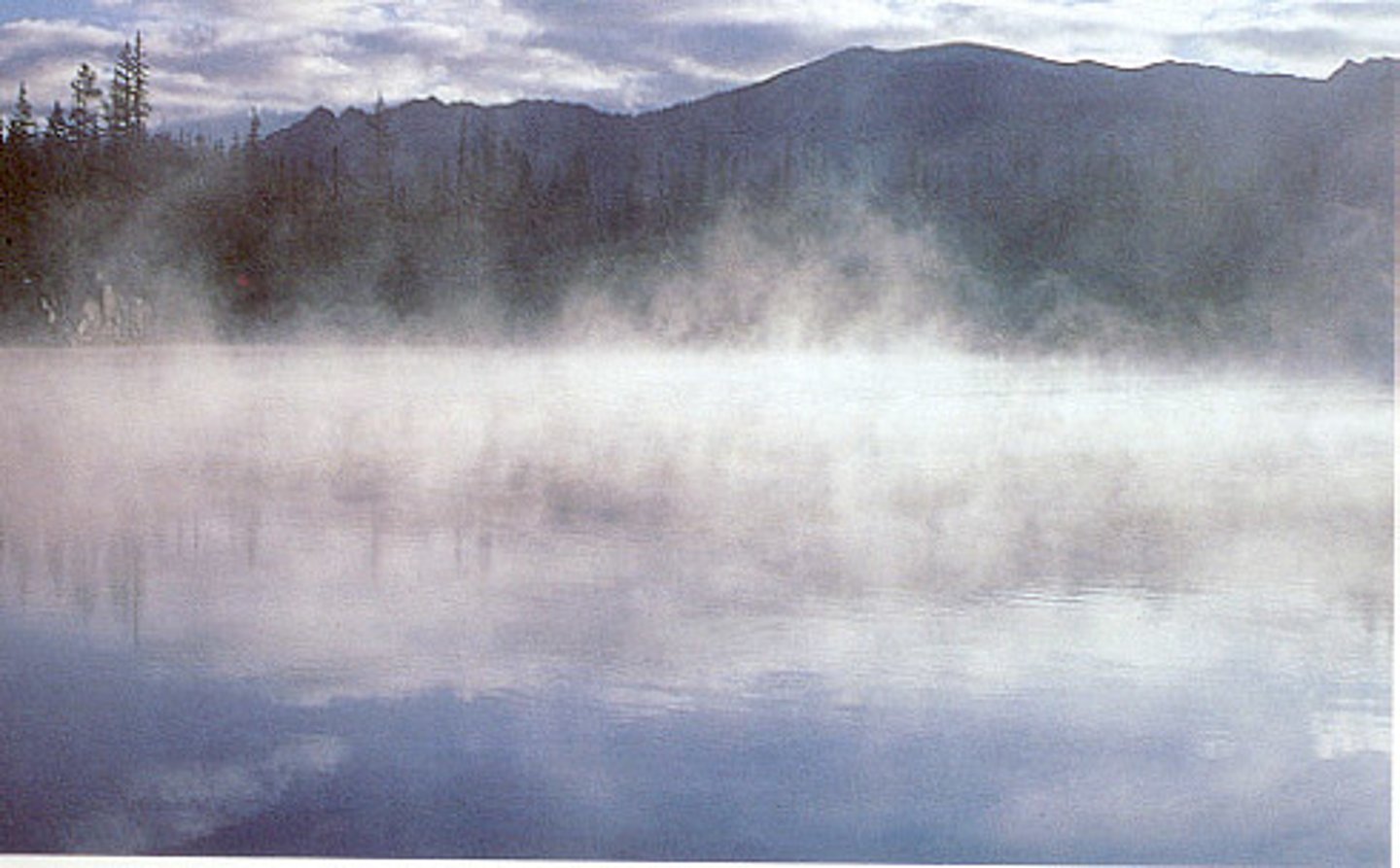
1.7 Transpiration
- the process plants use to draw groundwater from roots up to their leaves
- leaf openings called stomata then allow water to evaporate into the atmosphere from the leaf
- the movement of H2O out of the leaf creates low H2O potential in the leaf
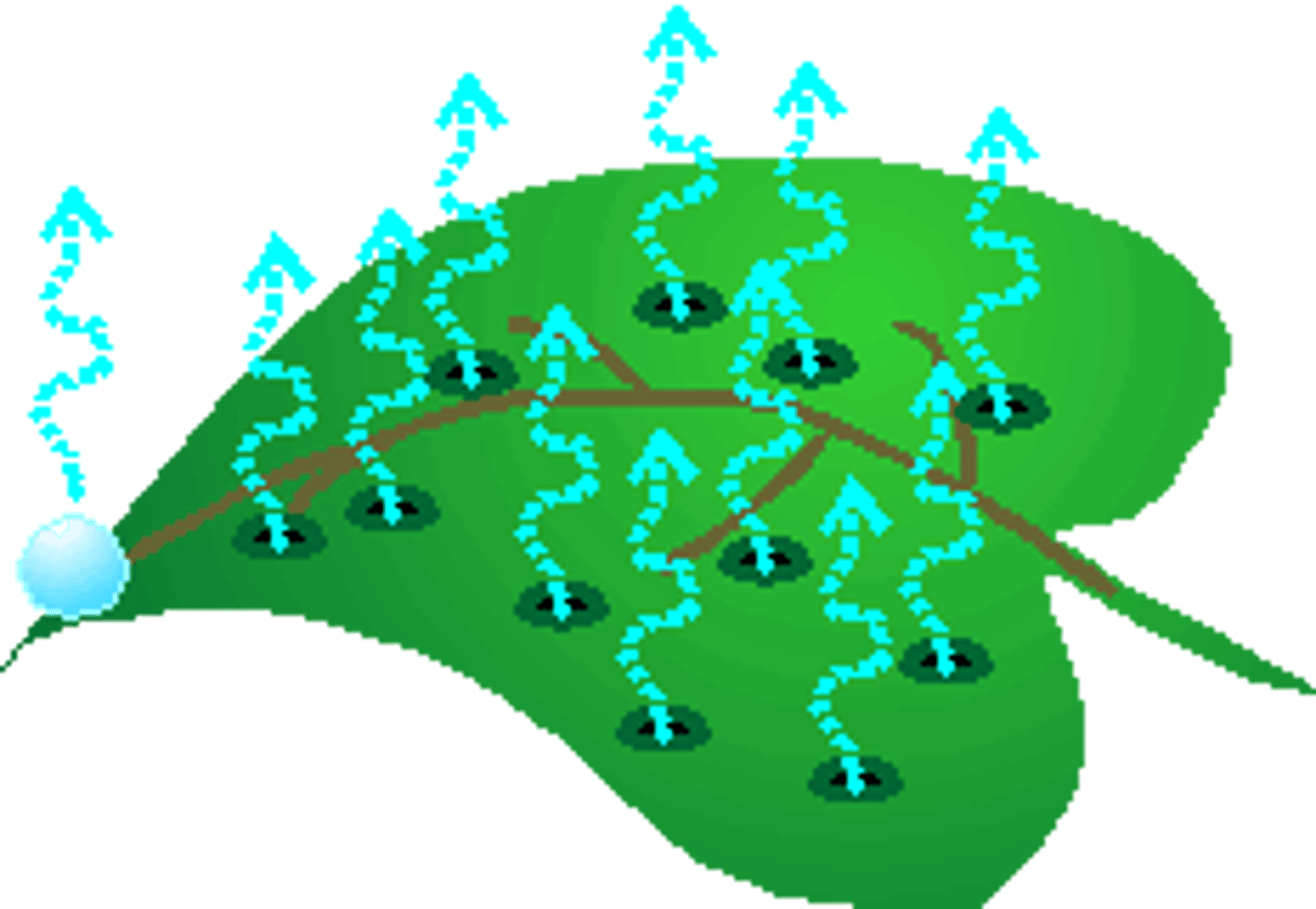
1.7 Evapotranspiration
amount of H2O that enters the atmosphere from transpiration and evaporation combined
1.7 Runoff and Infiltration
- precipitation either FLOWS (runoff) over Earth's surface into a body of water or TRICKLES (infiltration) through soil down into groundwater aquifers
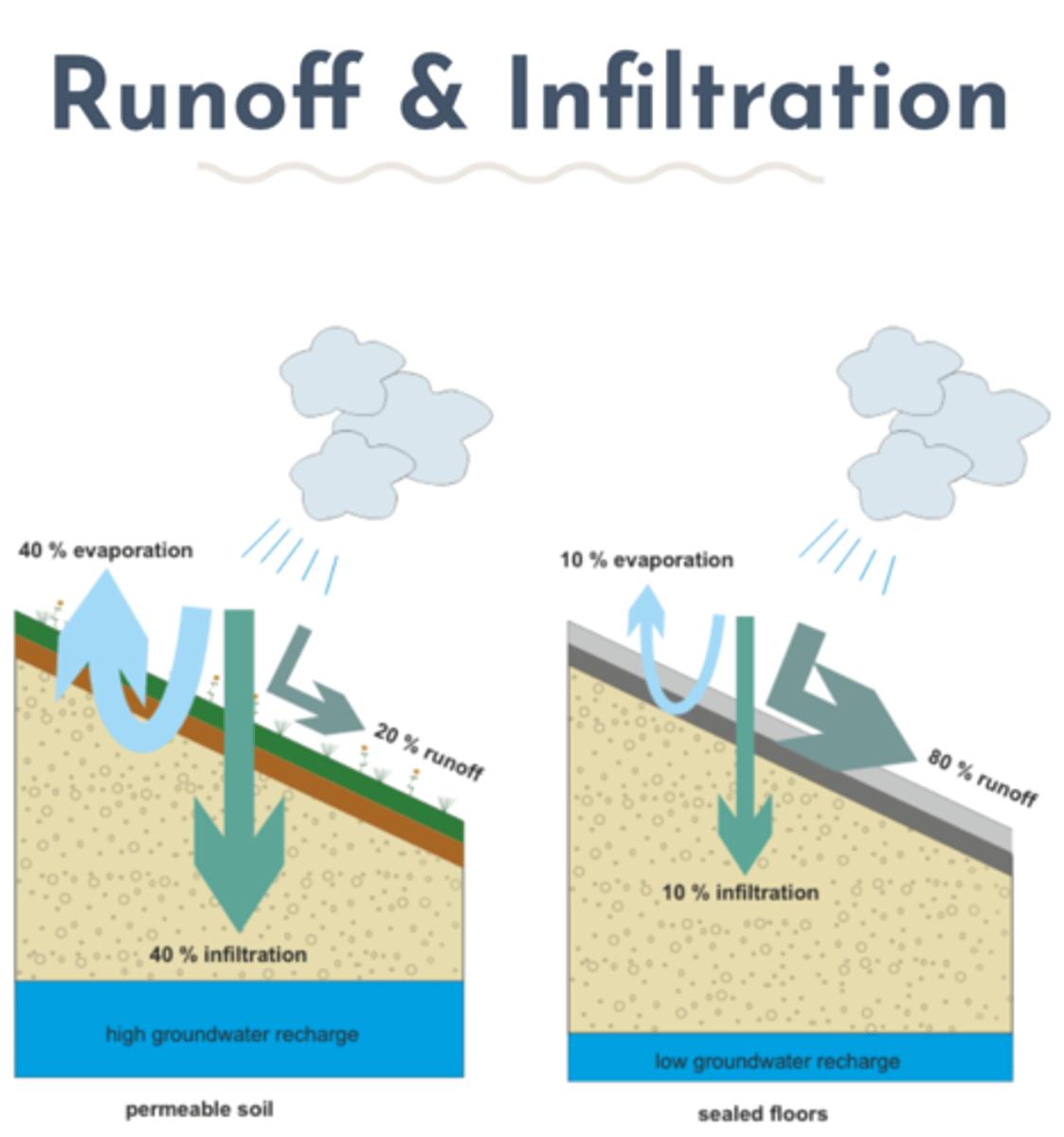
1.8 Primary Productivity
the rate that solar energy is converted into organic compounds like glucose or cellulose via photosynthesis over a unit of time (AKA: the rate of photosynthesis of all produces over a given period of time)